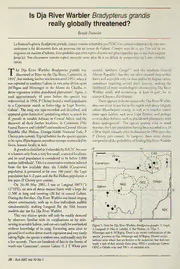
Is Dja River Warbler Bradypterus grandis really globally threatened? PDF
Preview Is Dja River Warbler Bradypterus grandis really globally threatened?
4 Is Dja River Warbler Bradypterus grandis really globally threatened? BenoitFontaine LaBouscarlegeanteBradypterusgrandis,classeecommevulnerableparl’UICNetconnueauparavantdeseptsites seulement aete decouverte dans un nouveau site au centre du Gabon. Compte tenu de ce que 1’on sait de ses exigencesenmatiered’habitat,ilestprobablequecetteespecediscretesoitplusrepanduequecequietaitsuppose jusqu’ici. Son classement comme espece menacee serait plus du a un defaut de prospection qua une veritable rarete. T he Dja River Warbler Bradypterus grandis was comm), northern Congo8,11 and the southern Central discoveredatBityeon the DjaRiver, Cameroon, in African Republic6 buttheyareoftensituateddeepwithin , 191 7,butnothingfurtherwasknownuntil 1951,whenit forestandaccessibleonlyonfootand/orbydugoutcanoe, wascapturedinsouthernGabon,intwoareas40kmapart sometimes requiring several days’ journey, making the (M’Bigou and Mimongo) in the Monts du Chaillu, in likelihood ofmost ornithologists encountering Dja River densevegetationwithinabandonedplantations9.Again, it Warbler small, and accounting, at least in part, for its took approximately 40 years before the species was scattered known distribution. rediscovered:in 1994, P Christyfoundasmallpopulation ThereappearstobenoreasonwhyDjaRiverWarbler in a Cyperaceae marsh at forest-edge in Lope Reserve, doesnotoccurinanybaiintheregionwithdense(slightly Gabon2. The song was tape-recorded and described, and saline) Rhynchosporaswamp, as well as in marshes within appearedquitedistinctive3 permittingotherstosearchfor more open habitat, such as in Lope Reserve, and perhaps , B. grandis in suitable habitats in Central Africa, and the even in drierhabitatssuch asabandoned plantationswith discovery of three further localities, in Cameroon (Nki dense undergrowth9. The species persists even in small FaunalReserveandLobeke4)andsouthernCentralAfrican marshes,theLopepopulationhavingbeenrecordedina10 Republic (Bai Hokou, Dzanga-Ndoki National Park; P x50mmarshannuallysinceitsdiscoveryin 1994(persobs, Christyperscomm).Typicalhabitatforthespeciesappears P Christy pers comm). In Langoue, three spots chosen tobeopenRhynchosporacorymbosaswampssurroundedby irrespectiveoftheprobabilityoffindingDjaRiverWarbler forest, known locallyas bais. B.grandisisclassifiedasVulnerablebyIUCN5,because 10° 15° itisknownonlyfromaveryfewsmall,scatteredlocalities, and its total population is considered to be below 1,000 matureindividuals1.Thisisaconservativeestimateinferred from the few available data: the Lobeke (Cameroon) population is presumed to be over 100 pairs4, the Lope populationhas 1-2pairsandtheBaiHokoupopulationa fewpairs (P Christypers comm). On 26-30 May 2001, I was at Langoue (00°1TS 12°33’E), an area ofdense mature forestwith alarge bai m (1,500 long and covering c20 ha) in central Gabon. Duringthefivedays,DjaRiverWarblerwasheardsinging almost continuously, with up to four individuals audible simultaneously, making Langoue Bai the fifth known modern-daysitefor DjaRiverWarbler. Thisveryelusivespecieswill onlybe readilydetected by observers familiar with its vocalizations or by mist- 10° 15° nettinginsuitablehabitat,andcanveryeasilybeoverlooked Figure 1.SitesforDjaRiverWarblerBradypterusgrandis. 1:Lope; without knowledge ofits song. Favouring areas close to 2:Langoue;3:Nki;4:Lobeke; 5: BaiHokou;6:Dja;7: groundlevelwithindensemarshvegetationandveryrarely Mimongo;and8:M’Bigou.Thereisnorecentconfirmationofthe takingflight,thespeciesisseldomseen,andusuallyonlyfor species’presenceatDja,MimongoandM’Bigou. Dottedcircles saofuetwh-seeacsotndCsa.mTehreoroena4r,eeahsutnedrnreGdasboofnba(iLsJinTthWehfiotreestpserosf iiOnmDdpilZcyat=aelOaadrcezkaasolfwahbaeariresae;obuaatinssdidaTereRtIkhen=soetwarnrie-atnsoa.tbiNoenEanlGumare=erano.ourst,h-beuatstdoGeasbonno;t 28-BullABC Vol 10No 1 Figures 1-2.DjaRiverWarblerBradypterusgrandis,NkiFaunalReserve,southeastCameroon,January 1998 (Fran^oiseDowsett-Lemaire) (twobeingobservationplatformsforelephantsandonean References elephanttrackleadingtothe bai) producedfour, twoand 1. BirdLifeInternational2000.ThreatenedBirdsoftheWorld. two singing birds, all ofwhich were probably different Barcelona: Lynx Edicions & Cambridge, UK: BirdLife individuals, as the three localities are well separated. International. Dowsett-Lemaire&Dowsett4mention‘atleastsixsinging 2. Christy,P. 1994.La“redecouverte”delafauvetteduDja birdsholdingterritoryinRhynchosporamarsh,inc6ha’and auGabon. Canopee2: 7. c‘aorpyaimrbohsoaldfionrgNakit.erFrirtoormytihnesae1f-ihgaurpesa,tcLhanogfoRuheynbcahiocsopuolrda 3. Crehsreirsvtey,deP.laaLnodpeC.laLrikbere,viWl.le:19E9C4.OFGuAiCdeGdaebsooni.seauxdela harbour20pairswithinitsc20ha.Astherearemanybais 4. Dowsett-Lemaire, F. and Dowsett, R.J. 2000. Birds of the Lobeke Faunal Reserve, Cameroon, andits regional in the region, it is probable that the total population importance for conservation. Bird Conserv. Intern. 10: exceeds 1,000 mature individuals. 67-87. This habitat is not threatened in the near future: 5. Hilton-Taylor,C. (compiler)2000.2000IUCNRedList logginginGabonisselective,withonly1-2trees/habeing ofThreatenedSpecies. Gland&Cambridge, UK: IUCN. removedinloggedareas10,andisusuallynotaccompanied 6. Klaus,G.,Klaus-Hiigi,C.andSchmid,B.1998.Geophagy by swamp drainage. There are significant areas offorest bylargemammalsatnaturallicksintherainforestofthe with bais that have not been subject to logging, partially DzangaNationalPark,CentralAfricanRepublic./. Trop. becausetheyaretoo remote, suchasthe Langouearea, or Ecol. 14: 829-839. because theyare incorporatedwithin protectedareas. 7. Ogilvie-Grant, W.R. 1917. Remarks on some recent Forthesereasonsandprovidedthatfurtherfieldwork collectionsofbirdsmadebyMrG.L.BatesinCameroon. in suitable habitat confirms that Dja River Warbler is Ibis 10: 72-90. reasonably common in bais in the area, the species is 8. Querouil,S.,Magliocca,F.andGautier-Huon,A. 1999. unlikelytomeetanyofthecriteriaforlistingasVulnerable5 Structureofpopulation,groupingpatternsanddensityof permittingitstransferraltoLowerRisk(NearThreatened),, f1o6r1es-t16e7l.ephants in north-west Congo. Afr.J. Ecol. 37: itspopulationbeingprobablynotmorethanafewthousand 9. Rand, A.L., Friedmann, FL and Traylor, M.A. 1959. mature individuals. BirdsfromGabonandMoyenCongo.FieldianaZool.41: 221-411. Acknowledgements 10. White, L.J.T. 1992. Vegetation history and logging Myobservationsweremadeduringastudyfundedbythe disturbance: effectsonrainforestmammalsintheLope Wildlife Conservation Society. I thank Lee White and Reserve, Gabon. PhDThesis. UniversityofEdinburgh. Ludovic Momont for permitting access to Langoue bai. 11. WildlifeConservationSocietyCongo2000.ParcNational Discussionswith Patrice Christyinitiated this paper, and de Nouabale-Ndoki, Republique du Congo: Plan I am grateful to him and Robert J. Dowsett, Franqoise dCo’nAgmoe.nagement 2000-2005. Unpubl. report forWCS Dowsett-Lemaire,LincolnFishpoolandOlivierGargominy fortheirconstructivecomments on the manuscript.($) LBIMM,Museumnationald’Histoirenaturelle,55rueBuffon, 75005Paris France.E-mail:[email protected]. , IsDjaRiver Warblerreallygloballythreatened?:Fontaine BullABC Vol 10No 1 -29
